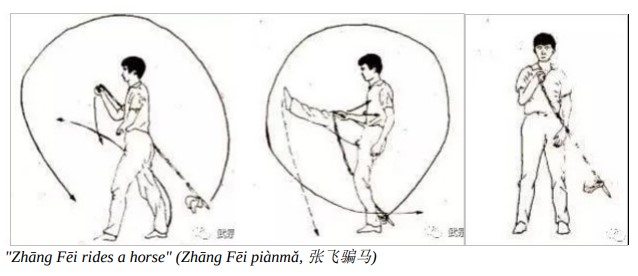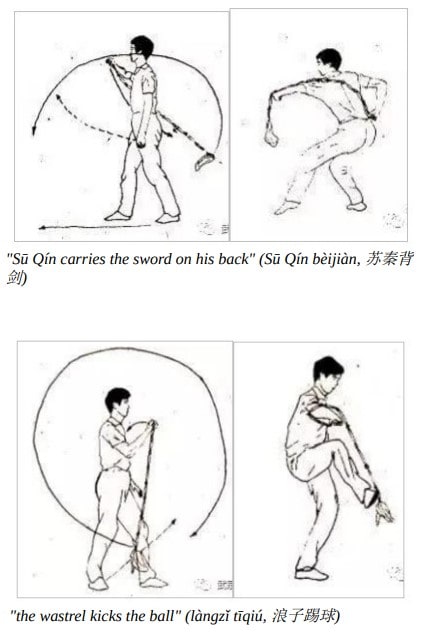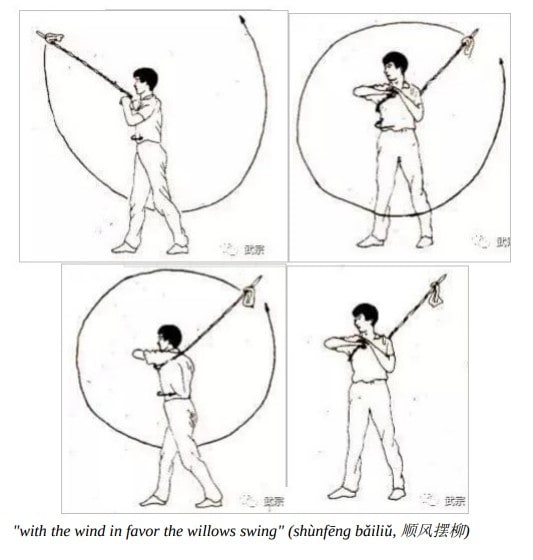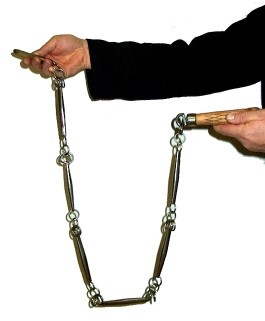The Chain Whip – A Weapon of Elegance and Precision
In the realm of martial arts, where skill and mastery of technique reign supreme, one weapon stands out for its unique blend of grace and lethality: the chain whip. It is a weapon that has captured the imagination of martial artists and enthusiasts alike, thanks to its fluid and mesmerizing movements.
In this article, we will delve into the world of the chain whip, exploring its origins, understanding how it is used, and even taking a closer look at the legendary martial artist Jet Li’s impressive command of this elegant weapon.
What is a Chain Whip?
The chain whip, often referred to as the soft whip within the realm of martial arts, is an exquisite weapon deeply rooted in the traditions of Chinese martial arts. It finds its place in both traditional Chinese disciplines and the world of modern and traditional wushu. This unique weapon is a testament to the ingenuity of martial artists, featuring a design that seamlessly blends flexibility with precision.
At its core, the chain whip consists of several metal rods, meticulously joined end-to-end by sturdy rings, forming a chain that embodies both strength and adaptability. One end of the whip is equipped with a handle, while the other end showcases a metal dart, strategically crafted for slashing or piercing an opponent.
An intriguing addition to this weapon is the cloth flag, often attached near the dart end, with the possibility of a second flag covering the whip’s handle. These flags serve a dual purpose: they enhance the visual appeal of the weapon and create a mesmerizing rushing sound as the whip gracefully arcs through the air.
This auditory element not only captivates spectators but aids the wielder in tracking the whip’s rapid movements, as it moves too swiftly for the naked eye to follow.
The chain whip is a versatile weapon with no standard length, its dimensions varying between regions of China. In the southern regions, it is typically shorter, making it exceptionally well-suited for close-quarter combat. In contrast, northern variations can range from ground-level to chin or nose-tip length.
The choice of length depends on the martial artist’s preference and combat style. Additionally, the weight of the chain whip varies for different purposes, with heavier versions designed for practice and lighter ones tailored for performance.
The flags adorning the whip can take two shapes: rectangular or triangular. Triangular flags offer a dynamic visual display, moving with greater speed, while rectangular flags produce a distinct sound and provide enhanced control to the wielder.
The number of segments in a chain whip can also differ. Traditional models typically feature seven or nine segments, whereas modern iterations may have between seven and thirteen sections.
The materials used in crafting chain whips have evolved over time, with most contemporary whips being constructed from stainless steel. Quality is paramount, with well-made whips featuring metal segments that boast superior color and shine.
The segments are thoughtfully stylized, and precision is maintained in their assembly, ensuring a seamless rotation within the swivel built into the handle. The construction prioritizes safety, with rounded edges and no sharp corners.
Strong welds ensure durability, while the handle is expertly shaped to facilitate a secure grip. Leather-wrapped handles are favored for their sweat-absorbing properties and slip-resistant qualities.
How to Use the Chain Whip
The art of wielding a chain whip is a mesmerizing blend of grace, precision, and force. Mastering this weapon requires an understanding of its unique characteristics, as the weight, length, and techniques involved all play crucial roles in its effectiveness.
The weight of the chain whip is a critical factor in its use. If the weapon is too heavy, the rotations become painstakingly slow, limiting its agility. Conversely, if it is too light, the force behind each strike may be insufficient to make an impact. Achieving the right balance is key to harnessing the full potential of the chain whip.
The nine-section metal whip, known for its versatility, can be easily carried. It can be coiled around the waist or comfortably held in the hand. When the moment to deploy it arrives, the practitioner unfurls it, ready to handle its fluid movements. This adaptability makes it a formidable weapon in various combat scenarios.
The essence of the chain whip lies in its ability to seamlessly combine the qualities of both hard and soft techniques. Its repertoire includes “windings” (chán), “swings” (lūn), “sweeps” (sǎo), “hooks” (guà), “flourishes” (pāo), and even “dancing flowers” (wǔhuā). These techniques form a complex tapestry of movements that can be as long as a flowing river or as short and sharp as a lightning strike.
The chain whip’s range of action primarily revolves around circular motions. Through the swinging of arms and the characteristic rotations of different body parts, these circles are expanded and controlled. Specific strokes of the whip intensify the “dynamic force” and allow the practitioner to change the orientation and the center of these circles.
Technical mastery of the chain whip requires the ability to “hit longitudinally on a line” and “hit horizontally on a plane.” The withdrawal of the weapon should evoke the poetic image of a “silk mouse entering the hole,” while its release should resemble the “fierce tiger coming out of the cage.” These vivid metaphors capture the essence of the weapon’s movements—smooth, precise, and powerful.
When practicing with the chain whip, the practitioner must embody the principle of “the body following the course of the whip.” The weapon and the person must move in harmonious synchrony, with “the whip following the movement of the person.”
The flow of the whip must remain uninterrupted, akin to dancing in a wheel-like motion. Horizontal flourishes should strike perpendicularly, and each posture must seamlessly connect with the next.
The chain whip is a study in contrasts. It must exhibit “softness like a rope” in moments of finesse and “hardness like an iron club” when delivering powerful strikes. The practitioner must navigate between these states, adapting to the demands of the situation.
Tips for Using the Chain Whip
The art of using the nine-section whip is characterized by a combination of grace and precision, often described as “striking ingeniously like a meteor and flowing like a whip.” This technique involves intricate movements that demand careful attention to detail and practice. Here are some key points to consider:
Wrist Mobility
The use of the chain whip relies heavily on the wrist’s fluid and precise rotational movements. Whether it’s deploying the whip, retracting it, carrying it on the back, or executing intricate maneuvers, the wrist’s agility is essential to ensure uninterrupted and concatenated actions. Neglecting this aspect can not only hinder the whip’s effectiveness but also pose a risk of accidental injury.
Utilizing Momentum
“Using momentum” is a foundational principle for the nine-section whip. Given the weapon’s considerable length, high speed, and inertia in movements such as windings, oscillations, sweeps, hooks, and flourishes, controlling these inertial forces, along with gravity and centrifugal force, is vital. Properly harnessing these external forces is essential for the whip’s manipulation and effectiveness.
Balancing Flexibility and Inflexibility
The practice of the nine-section whip revolves around the concept of “flexible and inflexible residing within each other.” This duality allows the practitioner to adapt to various situations.
Flexibility, akin to a rope, enables changes in direction and the entanglement of an opponent’s hands or weapons. Inflexibility, akin to a wooden root, empowers striking with sweeping motions that target vital areas of the opponent’s body.
Integration of Body and Weapon
Achieving mastery with the nine-section whip hinges on the seamless integration of the practitioner’s body and the weapon itself. This integration maximizes the potential of the weapon.
It requires understanding the principles of the whip, rigorous physical training to enhance one’s body, and a deep appreciation for how to wield it effectively in various stylistic practices.
Fluid Circular Movements
The whip’s movements primarily follow circular trajectories, amplifying the inertia of the whip’s head and enhancing the power of its strikes. Techniques such as swings, sweeps, windings, spiral windings, hooks, back-and-forth movements, flourishes, and dancing flowers all employ the swing of the arm as a pivot point.
These movements involve coordinated use of the wrist, arm, shoulder, neck, waist, legs, and other body parts to accelerate rotations and change the whip’s central axis and direction.
Circular Trajectories
When the nine-section whip is in motion, it should follow circular trajectories to maximize the whip head’s inertia and amplify the power of its strikes. Common movements include swings, sweeps, windings, spiral windings, hooks, back-and-forth actions, flourishes, lifts, and dancing flowers.
These maneuvers leverage the swing of the arm as a pivot point, utilizing various body parts like the wrist, arm, shoulder, neck, waist, and legs. This coordinated approach results in changing the central axis and the direction of the whip’s circular motions.
Integration of Body and Weapon
Successful execution of these whip techniques requires seamless integration of the practitioner’s body with the weapon. The whip’s movements should remain closely attached to the body throughout various actions, providing stability and control.



Technique and Precision
The whip techniques emphasize precision and control. Practitioners must pay attention to “a step a movement, a movement a change, a change a flower,” which creates a fluid and interconnected flow of movements. The goal is to achieve a sense of continuous motion and mastery over the whip’s various actions.
Safety and Technique
To ensure safety and effective execution, practitioners should be mindful of several key factors. These include proper extension of the whip body, the technique for grasping the whip handle, the method of releasing the whip, dexterity in picking up the whip, and maintaining a stable foot position to avoid injury.
Combat Application
In combat scenarios, the nine-section whip is versatile. It can be used to entangle an opponent’s limbs or weapons with precise, wrapping movements. When required, it can also deliver powerful strikes to vital areas, thanks to its flexibility and inflexibility.
Variety of Moves
The nine-section whip boasts an array of moves and patterns, each with its poetic name. These moves often involve intricate and unexpected actions, such as wrapping around the arm, spiraling around the neck, or sweeping the legs. The variety of moves keeps opponents off balance and creates a dynamic and effective combat style.
Continuous Practice
Mastery of the nine-section whip comes with continuous practice. Skill is honed through repeated exercises, resulting in a seamless and controlled execution of the whip’s techniques. The saying “skill arises from practice” emphasizes the importance of regular training.
Jet Li Using the Chain Whip
Conclusion
From its humble beginnings as a tool of self-defense to its current status as a symbol of martial prowess and elegance, the chain whip has woven itself into the fabric of martial arts history. As we’ve seen, the chain whip is more than just a weapon; it is a work of art in motion, a dance of danger, and a testament to human ingenuity.
Whether you’re a seasoned martial artist or simply an enthusiast, the chain whip offers a captivating journey into a world where elegance and precision combine to create a truly exceptional martial experience. So, if you ever find yourself intrigued by this weapon’s hypnotic grace and formidable power, don’t hesitate to explore its secrets and embrace the world of the chain whip.

